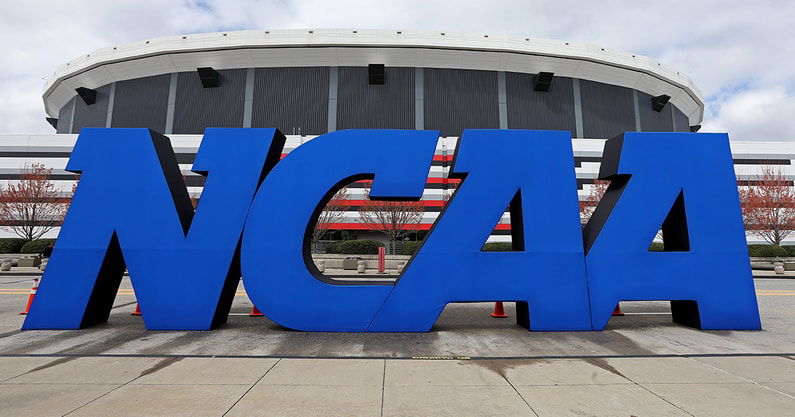
Getty
Mandatory Credits: Streeter Lecka/Getty Images

Getty
Mandatory Credits: Streeter Lecka/Getty Images
August 1 flipped the entire recruiting playbook. With the long-awaited House settlement finally coming into effect, college football programs are now officially allowed to hand out revenue-sharing contract offers to high school seniors. Now, it’s no longer verbal promises or NIL smoke signals. Recruits can get actual, formatted, dollar-stamped documents. But there’s one thing. Almost no one wants to be first. And why is that so?
Watch What’s Trending Now!
The thing is these contracts can’t be signed until December’s National Signing Day. So until then, they’re essentially leveraging tools for recruits and a scouting report for the competition. As Pete Nakos reported in an X post on August 1, “Schools can offer rev-share contracts to recruits today but can’t be signed until NSD. Some top programs are extending contracts, but other programs tell @On3sports they’re sitting on the sidelines b/c deals will be shopped.” No wonder many of the sport’s top programs are playing it safe and holding their cards close.
Schools can offer rev-share contracts to recruits today but can’t be signed until NSD.
Some top programs are extending contracts, but other programs tell @On3sports they’re sitting on the sidelines b/c deals will be shopped.
“It’s not smart.”
More: https://t.co/qp4PvTbkNU pic.twitter.com/zW5xZNCcxW
— Pete Nakos (@PeteNakos_) August 1, 2025
ADVERTISEMENT
As one Power 4 GM told On3, “They can’t sign anything until December, so there’s really no point. People would be dumb to do it.” Well, why give someone a contract they’ll just shop around? That’s the fear echoing through war rooms across the Power 4. Recruits and agents could take these preliminary offers and use them to build a bidding war. Some schools are even worried about the legal language of the contracts being leaked to competitors. “We have them prepared, but we are in wait-and-see mode. I just don’t see the need and feel like they can be used against us,” another GM voiced out. “Most of our recruits, families and agents have seen at least the format and structure of our agreement. It’s not smart.”
Despite the risks, some schools are already pushing the envelope. Sources told On3 that some programs have sent full contracts with exact compensation figures to agents before Aug. 1 even hit. And in some cases, schools are already paying recruits monthly just to keep them warm. Kirby Smart mentioned this earlier in the SEC spring meetings how third-party NIL collectives are paying recruits. Sources told On3 that elite high schoolers are earning $5,000 to $25,000 per month before ever playing a snap in college. “The price in August is not going to be what it is in November or December,” another source said. “Especially when flip season comes around.” So why does August 1 matter, even if not everyone is ready to sign?
ADVERTISEMENT
The $20 million game begins
“That’s a big day,” Auburn AD John Cohen previously said of August 1. Now that the revenue-sharing era is live, schools are working with a formal pool of about $20.5 million to be distributed across all sports. But for most programs, football is eating the lion’s share. Most Power programs are reserving 75% of that pie for the gridiron. That’s roughly $15.4 million, and it’s available to be shared to recruits, starting now. “It’s not rumor [of how much you are offering],” he said. “It’s not innuendo. It’s not, ‘This person said this.’ It’s an offer on paper,”
It’s important to note that this revenue-sharing money is separate from NIL earnings. NIL still lives in its own chaotic corner often controlled by third-party collectives. Revenue-sharing, on the other hand, comes directly from the schools, making it a far more structured and likely more scrutinized system. But that leaves roster retention and portal strategy in limbo. That $15 million might look large, but once you factor in transfer portal additions and keeping current players from jumping ship, it shrinks fast. That’s why many programs are choosing to wait. Because they simply don’t know yet what their roster will look like come December.
ADVERTISEMENT
“It’s going to come back to the top 25, 50 players in the country,” said one personnel director. “If you’ve got one of them, you’re probably sitting there thinking about [making an official offer]. It’s going to be more of a reflection of, ‘Do we have to [pay] in order to keep the guy?’” But don’t think for a second that only committed players are getting attention. One recruiting director told On3 that his school is specifically targeting players committed elsewhere, offering large figures just to reopen the conversation. “We’re going to try to use that to our advantage at the end of the day and put numbers in front of somebody and get them re-interested,” he said. And that’s the heart of this new era. Some guys will get paid. Some won’t. But now, the numbers are in black and white and every recruit is about to learn just how much they’re really worth.
Top Stories
Prayers Pour In From Terrell Owens as 275lbs Former Cowboys Player Announces Major Health News

NFL Make Final Punishment Decision on Controversial Patrick Mahomes Incident

Footage Surfaces of Florida Police Arresting NASCAR Veteran Over Disturbing Public Misbehavior

Dan Campbell Loses Faith in Locker Room After Clearing Stance on NFL Officials’ Controversial Decision

Mike Tomlin Breaks Silence on DK Metcalf Incident as Steelers WR Risks $277K Punishment

Olympic Champion Dominique Dawes Confirms Heartbreaking Outcome in Missing Family Member Search

ADVERTISEMENT
ADVERTISEMENT
ADVERTISEMENT

